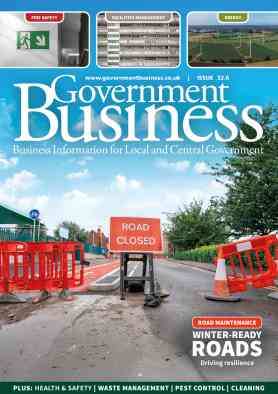
Smart solutions for food waste
Food waste in the UK is a big problem, equating around 10.7 million tonnes. By weight, 60 per cent of total food waste comes from households, more than waste food from farms, manufacturing, hospitality, and retail combined. The value of the edible parts of household food waste in 2021 amounted to £17 billion, which is £250 per person per year. This puts considerable strain on councils, supermarkets, and individuals to limit individual food waste.
Food waste is both a financial burden, as well as an environmental one, as food waste releases gases like methane as they breakdown in landfill. The charity Waste and Resources Action Programme (WRAP) estimates that the greenhouse gas emissions associated with waste food and drink in UK households alone accounted for approximately 18 million tonnes of C02 equivalent in 2021 and 2022.
Waste management in the UK is devolved, and is also managed by councils, meaning that some local authorities collect food waste as a separate waste stream, and others do not. All of this is set to change, however, now Simpler Recycling legislation has come into place. As of 31st March 2025, businesses and non-domestic premises across England will need separate waste streams for glass, metal, plastic, paper, and food waste, with this legislation to be extended towards households on 31st March 2026. A key detail for councils is weekly food waste collections, which are in various stages of progress across the country, with some councils already carrying out this measure and some needed to put a plan into action.
As it stands, councils are already under increased financial pressures, with one in five potentially facing insolvency by the end of 2025. Under tightening budgets, councils will need to deliver essential services, whilst also implementing stricter waste management measures imposed by the government. The Department of Food and Rural Affairs does have aid available, but this will not cover the full cost of collecting and disposing of food waste, with come councils concerned that this capital funding is not enough.
This might sound worrying, but local authorities are also channelling innovation by increasingly turning to data and technology to tackle food waste at its source, letting them shift reactive waste management to proactive waste prevention.
Technology
Nowadays, there is a wealth of technology available that can help with reducing food waste, from tracking produce on its journey to supermarket shelves, to harnessing artificial intelligence (AI) by calculating when some foods might be more popular than others. All of these technologies work to reduce food waste at its source, which is particularly important as, according to WRAP, 75 per cent of edible food waste did not need to have been thrown away.
Internet of Things
Internet of Things (IoT) describes a network of physical items (“things”) that form a network once connected using sensors, software, and other technologies. Connecting objects to the cloud allows them to exchange data with other IoT devices and those working with them. IoT devices could thus be used to track food as it is transported to supermarket shelves using sensors that monitor temperature, humidity, and other environmental factors that affect shelf life. IoT could also be used in inventory management, allowing companies to track stock levels and predict when restocking is needed, preventing food stuffs from being overstocked.
Artificial Intelligence
Using AI, demand patterns for certain products can be analysed, providing insights to ensure the right amount of produce is grown. AI algorithms can additionally predict which products are at risk of spoiling before they are inedible, freeing up administrative burdens from workers and allowing them to focus on redistribution, rather than also keeping track of entire inventories of stock.
Data and analytics
Supply chain data can be analysed to identify inefficiencies and areas for improvement, which will prevent losses during transport and storage, and predictive analysis can be gathered from data. This will help producers and retailers better plan their production and purchasing levels, reducing the risk of surplus that could end up discarded.
Opportunities for councils: smart bin sensors
These technologies work best when implemented along the supply chain, with farmers, distributors, retailers, and central and local governments working together to reduce food waste. Some strategies, like using AI to calculate supply and demand for farmers, are exclusive to certain environments, and aren’t also applicable
o local authorities.
Smart bins, however, can be used by the council to intercept food waste before it makes it into landfill, where its breakdown will release greenhouse gases. First used in the UK in 2011, several trials by local authorities have proved successful, with many councils implementing them in their communities. The bins alert councils when they are almost full, which reduces the number of useless trips waste management workers need to carry out, lowering costs, carbon emissions, and boosting local authorities’ productivity and efficiency.
Smart bins have sensors that provide insights into the amount and type of waste in the bin, and have fill-level sensors that recognise when the bin is almost full. Powered by the sun, compactors compress waste, allowing them to fit up to eight times the amount of waste and prevent overflowing.
Some bins also filter waste depending on what it is, ensuring no recycling or food waste ends up in landfill, allowing food waste to be transformed into energy, fertiliser, or compost.
Numerous councils across England have implemented smart bins, with Manchester City Council spending £250,000 on 51 solar-powered smart bins, City of Wolverhampton installing 700 smart sensors in pre-existing bins, and Liverpool City Council having trialled 20 ‘super’ smart solar bins last summer.
Food distribution
In February, the Department of Food and Rural Affairs announced that it would deliver £15 million for food distribution charities, with grants starting from £20,000. Named Tackling Food Surplus at the Farm Gate, the scheme aims to solidify links between farms and charities, giving funds to charitable distributors to ensure that surplus food reaches those who need it most. Although applicants must be from the not-for-profit sector, partnerships are allowed to enhance distribution, which could foster collaborations between councils and charities.
Charities specialising in distributing food surplus to those who need it most often collaborate with local councils, and can benefit from local authorities’ increased resources, manpower and connections with the wider community. In Richmond, for example, the local charity The Real Junk Food Twickenham runs regular food surplus food distribution session at the Linden Hall Community Centre.
Hounslow Connect, part of Hounslow Council, has partnered up with the Felix Project to offer free fruit and vegetables that would have otherwise gone to waste. The Felix Project is London’s largest food redistribution charity that aims to ensure food that would otherwise have gone to waste is instead feeding families in need.
Although councils are under immense pressure: to work with tightening purse strings, to show tangible change to their communities, and to implement new food waste regulations, they are showcasing both resilience and adaption through taking up technological and digital methods to reduce food waste at the source.


